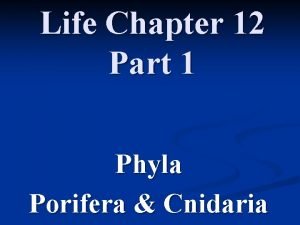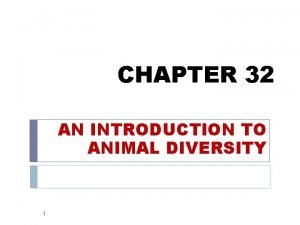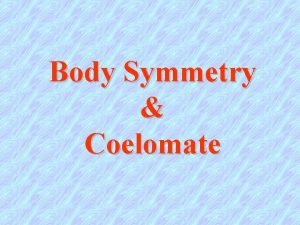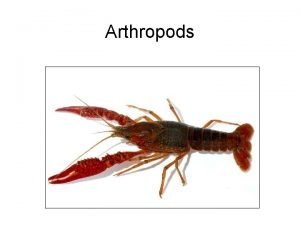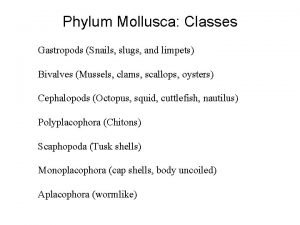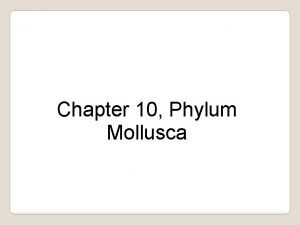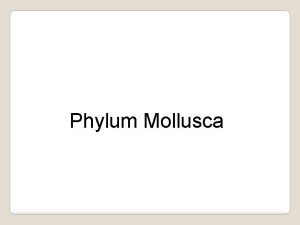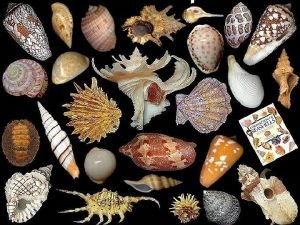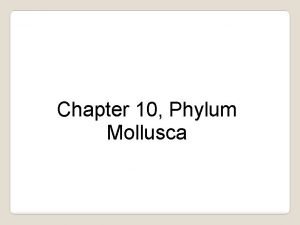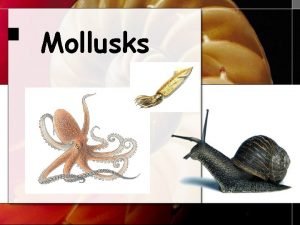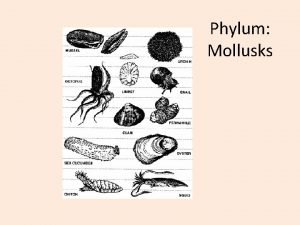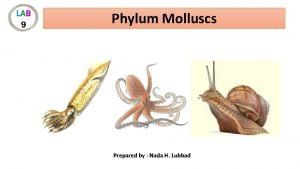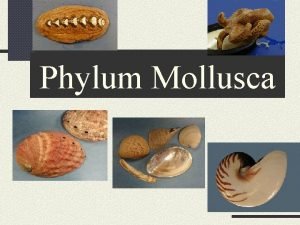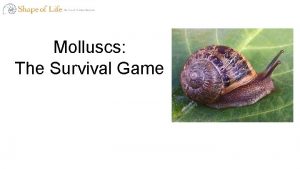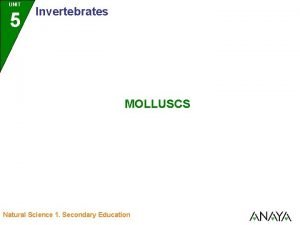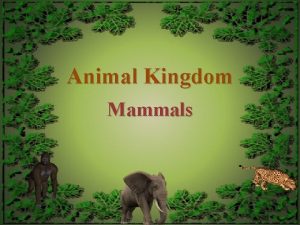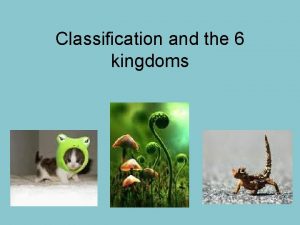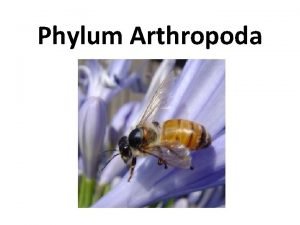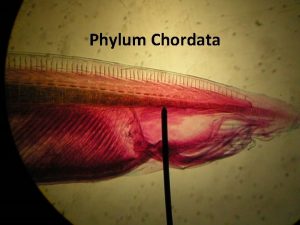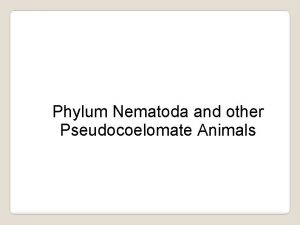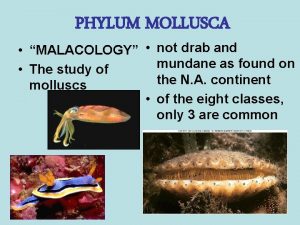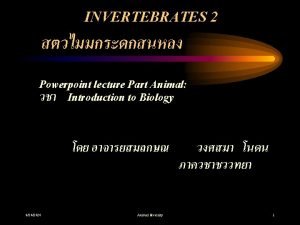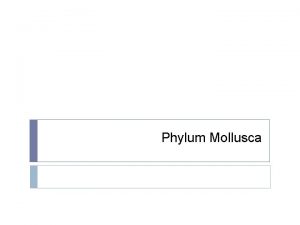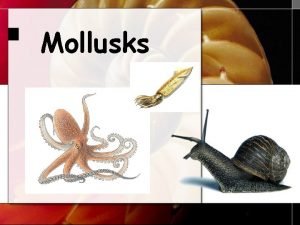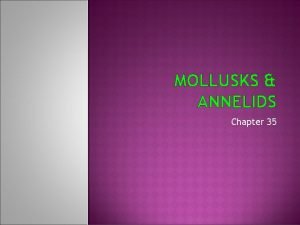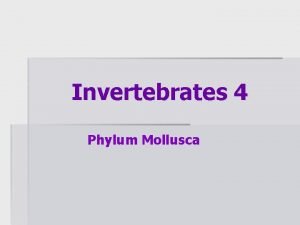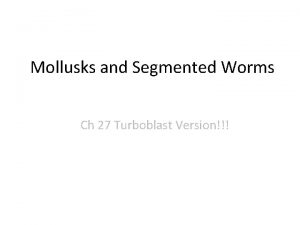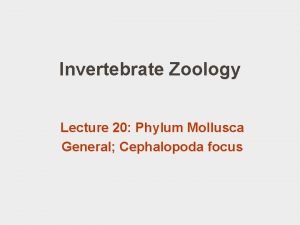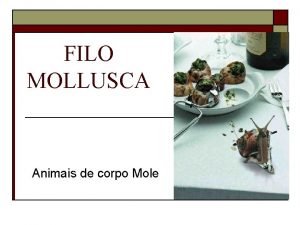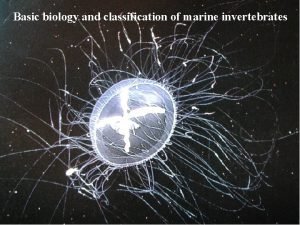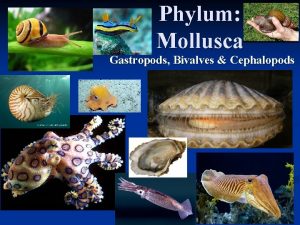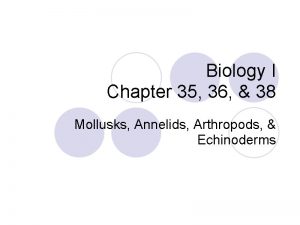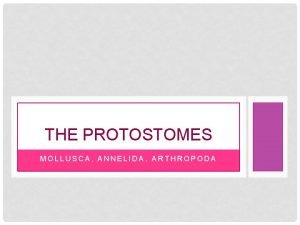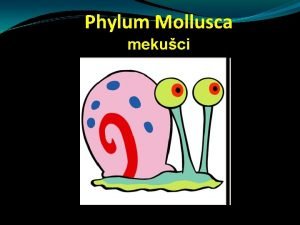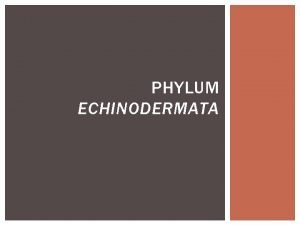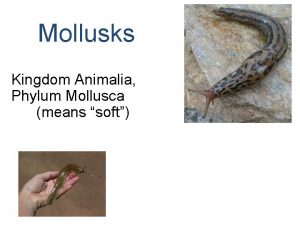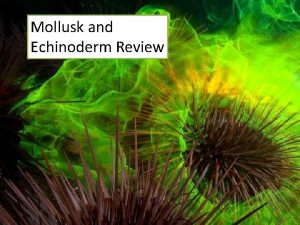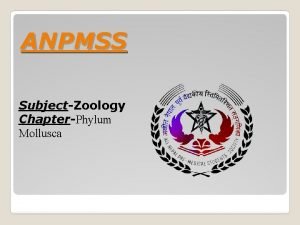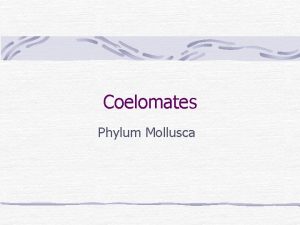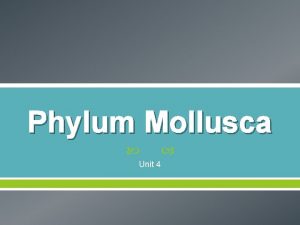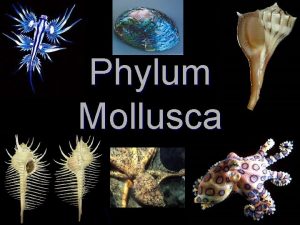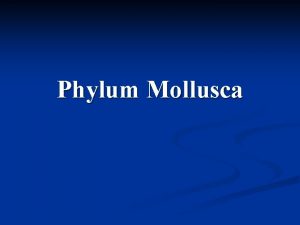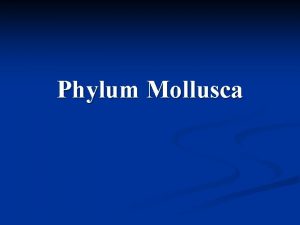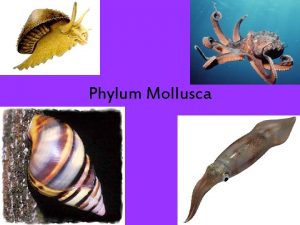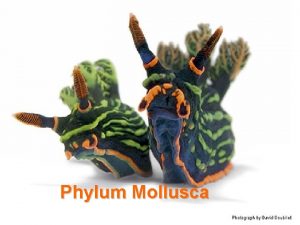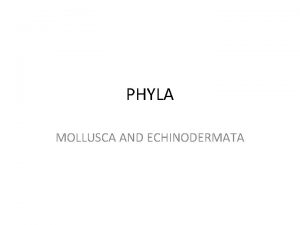Phylum Mollusca Chapter 16 Molluscs True coelomate animals

















































- Slides: 49

Phylum Mollusca Chapter 16

Molluscs True coelomate animals Protostome – Mouth first Trochophore larva – free swimming All organ systems present Gills or lungs Fleshly mantle that secretes the shell holds gills or lungs

Bilateral symetry Unsegmented Cephalization Open circulatory system – closed in cephalopods

Unique to phylum are the radula Muscular foot Direct eye from skin not brain




50, 000 living species 35, 000 fossil species Mollusca means soft body Chitons, snails, slugs, nudibranchs, clams, mussels, oysters, squid, octopuses Microscopic to the Architeuthis 18 m to 450 Kg


Found in habitats from the tropics to the polar seas Originated in the oceans Most evolution happened near shores Only bivalves and gastropods moved to brackish and freshwater habitats

Form and function Head – foot Active area Feeding Sensory organs Locomotion Radula- locomotion Visceral mass Digestive Circulatory Reproductive Ciliary tracts

Radula Rasping, protruding tonguelike organ Found in all molluscs but bivalves Ribbonlike membrane covered in tiny teeth Complex muscles move the radula in and out Few teeth to 250, 000

Tear off food Conveyer belt for carrying to digestive system New rows are continuously replaced Pattern and number of teeth are unique to each species

Foot Locomotion Attachment Combinations of these Ventral solelike structure Waves of muscular contractions

modifications Attachment disc in limpets Laterally compressed hatchet foot in bivlaves Siphon for jet propulsion in the squid Secreted mucus is an aid to adhesion or gliding

Snails and bivalves can extend the foot hydraulically by engorgement with blood Can extend in mud or sand use as an anchor In free swimming ( pelagic)+ forms is modified to winglike or thin fin structures

Visceral Mass/Mantle Cavity Mantle – sheath of skin that hangs down on each side of body Protects soft parts and creates mantle cavity between it and visceral mass Outer surface of mantle secretes the shell

Mantle Cavity Houses respiratory organs Products from digestive, excretory and reproductive systems deposit in cavity Water currents connect cavity to outside environment Jet propulsion for locomotion

Sensory receptors to sense outside environment Head can be withdrawn into cavity for protection

Shell Secreted by the mantle continuously Increases in thickness as animal ages 3 layers thick Periostracum, prismatic, nacreous Protein, calcium carbonate and crystalline calcium carbonate

Shell The first shell appears during larval period then grows as animal ages Protection/support Calcium comes from food/soil/water Mother of pearl/nautilus/conch etc. Many ornate varieties

Internal structure and function Gas exchange – body surface (mantle) gills and lungs Open circulatory system Pair of kidneys- metanephridia Also can serve do discharge eggs and sperm

Nervous system consists of several pairs of ganglia with connecting nerve cords Cephalization

Reproduction and history Some hermaphroditic but most are dioecious ( separate male and female) Free swimming larva that emerges from egg is called the trochophore Veliger – 2 nd free swimming stage found in some bivalves and gastropods – has beginning of a foot, shell and mantle

In some cases the trochophore is passed in the egg then the veliger emerges In cephalopods, some marine and fresh water snails and some freshwater bivalves there is no trochophore stage the juvenile hatches from an egg

Classes of Molluscs 8 classes Caudofoveata–wormlike/marine Solenogastres-wormlike/marine Monplacophora-small rounded shell Polyplacophora-chitons/flattened Scaphopoda-tooth shells

Gastropoda-snails/slugs/conchs Bivalvia-clams/mussels Cephalopodasquids/nautiluses/octopuses

Caudofoveata Wormlike Marine 2 -140 mm Burrowers Terminal and mantle cavity at entrance of burrow

Microorganisms and detritus No shell but covered in calcareous scales Has radula 70 species or less Closer to common ancestor

solenogastres Marine Wormlike Use to be in same class as caudofoveata No shell but covered in calcareous scales No radula

No gills Hermaphroditic Free swimming Feed on cnidarians 250 species

Monoplacophora Extinct until 1952 At least 12 species now known Small with low rounded shell Look like limpets Some serial repetition of internal organs Many internal organs are paired

Ladderlike nervous system Mouth contains the radula

Polyplacophora Chitons Diverse moluscan group Flattened dorsally and ventrally 8 articulating limy plates Many plate bearers Head and sensory organs reduced

Photosensitive structures called Esthetes 2 - 5 cm Rocky surfaces in intertidal areas Stay near living area Have radula

Mantle forms girdle around margin of plates Extened along side of foot Gills suspended from roof of mantle cavity Mantle margins can be held open for air breathing

Osphradia – sense organs for sampling water are found in the mantle grooves

Scaphopoda Tusk shells Tooth shells Benthic marine molluscs Subtidal zone to 6000 m Slender body Covered by mantle and tubular shell

Mantle wraps around visceral mass to form a tube 2. 5 to 5 cm long Foot is used to burrow Gills are absent Food is detritus and protozoa

Long tentacles extend from the head Captacula – brings food to radula No eyes, tentacles, osphradia Sexes separate Trochophore larva

Bivalvia Pelecypoda Hatchet footed Mussels, clams, scallops, oysters etc. 1 mm – 1 m (giant south pacific clam) Filter feeder – ciliary currents by gills No radula

Little cephalization Marine, brackish, fresh Two shells Adductor muscles Umbo – oldest part of the shell

Pearl – results from foreign object between the mantle and shell Locomotion occurs by extending slender foot between valves. Blood swells foot and acts as an anchor Some swim by clapping shells gills

Separate sexes Fertilization is both external and internal Trochophore, veliger

Cephalopoda Head-foot Squids, octopuses, nautiluses Modified foot at head region Funnel for expelling water from the mantle cavity 2 -3 cm – 30 cm Cambrian times

Internal shells or no shells Swim by expelling water from the mantle cavity through a funnel or siphon Most have one pair of gills Closed circulatory

Separate sexes Internal fertilization No free swimming larva

Gastropoda Largest and most diverse 40, 000 living Snails, slugs, sea hares etc. Marine to air-breathing Bilateral symmetry Microscopic to giant

Stomach foot Feeding is varied but does include a radula Torsion – moves mantle to the front of the body Fertilization is internal
 Symmetry porifera
Symmetry porifera Schizocoelous coelom formation
Schizocoelous coelom formation Coelomate
Coelomate Pattern of organization
Pattern of organization Jointed appendages meaning
Jointed appendages meaning Limpets phylum
Limpets phylum Mollusca open circulatory system
Mollusca open circulatory system Phylum mollusca homework and study guide #1
Phylum mollusca homework and study guide #1 Mollusc symmetry
Mollusc symmetry Oluska
Oluska Gastropods characteristics
Gastropods characteristics Mollusca characteristics
Mollusca characteristics Mollusks life cycle
Mollusks life cycle Classes in phylum mollusca
Classes in phylum mollusca Nephridia in molluscs
Nephridia in molluscs Taxonomy
Taxonomy Why dont all radulas look alike
Why dont all radulas look alike Molluscs
Molluscs Chapter 2 jesus christ true god and true man
Chapter 2 jesus christ true god and true man Playtpuses
Playtpuses Types of kingdom
Types of kingdom Largest animal phylum
Largest animal phylum An animal that has a notochord
An animal that has a notochord Rotifera pronunciation
Rotifera pronunciation Kyle douglass
Kyle douglass Producers consumers and decomposers
Producers consumers and decomposers Which energy
Which energy Animals that eat both plants and animals
Animals that eat both plants and animals 102 dr
102 dr Buccal bulb
Buccal bulb Phylum squid
Phylum squid How do mollusks reproduce
How do mollusks reproduce Oysters phylum
Oysters phylum Peristaltic movement
Peristaltic movement Mollusca body plan
Mollusca body plan Mollusks segmentation
Mollusks segmentation Polyplacophora
Polyplacophora Mollusca
Mollusca Simetria mollusca
Simetria mollusca Crustaea
Crustaea Millipedes phylum
Millipedes phylum Gastropod vs cephalopod
Gastropod vs cephalopod Oligocheta
Oligocheta What phylum
What phylum Brachiozoa
Brachiozoa Sipunculida
Sipunculida Mollusca endoskeleton
Mollusca endoskeleton Mollusca kingdom
Mollusca kingdom Endoskeleton mollusca
Endoskeleton mollusca Symmetry of mollusca
Symmetry of mollusca
